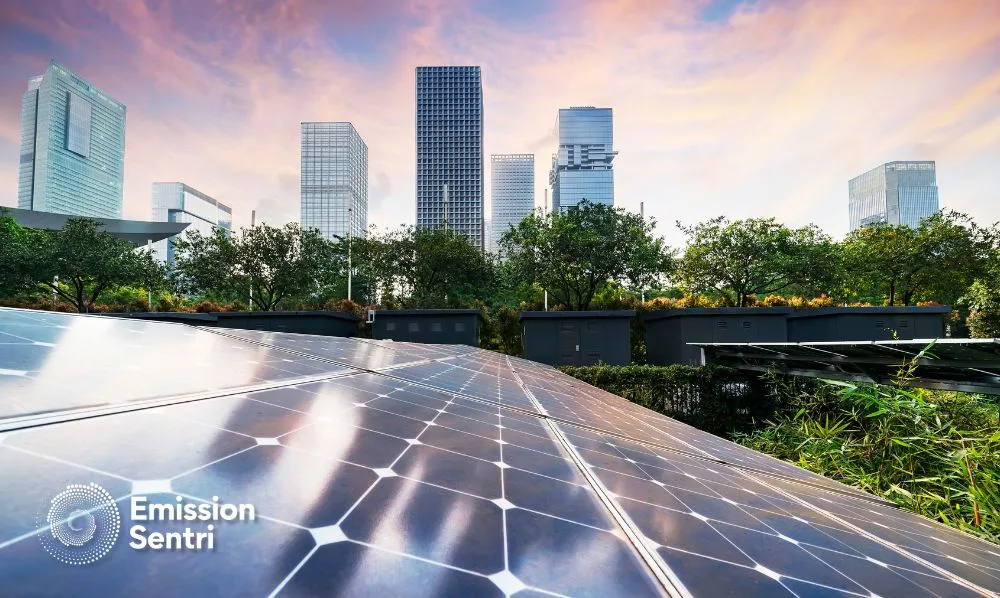Blog
Steal These 4 Excellent Sustainability in the Workplace Examples
Last updated: May, 2023

What if every time you clock in at work, you’re not just earning a paycheck, but you’re also helping the planet?
Well, it’s not just a pipe dream.
leading companies like IKEA, Patagonia, Nike, and Intel are proving that businesses can thrive without thrashing the planet.
While your business might not be on multi-national giants (yet), you can still do a lot to reduce your emissions and reap the benefits of corporate sustainability.
What is Sustainability in Business?
In a sustainable business, profit, the environment, and social commitment coexist in harmony.
In a nutshell, it’s about ensuring there is always balance between these three pillars and that no activity negatively impacts the other.
Achieving corporate sustainability means your business is green and has minimal to no negative impact on the environment, society, or economy.
RELATED: The Best Employee Engagement Solutions
4 Real-Life Sustainability in the Workplace Examples
Here are how some of the biggest corporations in the world are working towards their sustainability goals and reducing their environmental impact.
1. IKEA
IKEA, an international furniture company, is a leader in corporate sustainability. Over the last couple of years, IKEA has changed its business practices to tackle climate change and unsustainable consumption.
Here’s what the company’s sustainability strategy has achieved so far:
- 99.5% of the wood used for IKEA products is Forest Stewardship Council-certified or recycled.
- The company is 35% more energy efficient since switching to SOLHETTA LED bulbs.
- In 2021, IKEA reached its global goal of 100% renewable electricity for all its factories, packaging, and distribution units.
- In 2021, 55.8% of its materials were renewable, and 17.3% were recycled.
- IKEA no longer sells non-rechargeable alkaline batteries.
And there’s more.
To reduce food waste, IKEA has started producing plastic products from industrial and household waste.
The company is also in the process of phasing out single-use plastics.
It will begin with all new products in 202, and by 2028, the entire range will have packaging solutions centered around renewable and recycled materials.
2. Patagonia
Patagonia consistently ranks as one of the top sustainable companies in the world. In 2019, the outdoor clothing brand was named the UN Champion of the Earth because of its commitment to sustainability.
In 2023, Patagonia became the Most Sustainable Corporate Leader, overtaking Unilever, who held the spot for over a decade.
But what are Patagonia’s corporate sustainability initiatives?
- 100% of its virgin down is responsibly sourced.
- 85% of its products are made in a Fair Trade Certified factory.
- Between 2022 and 2023, the company repaired 83,794 garments at its Nevada repair center.
- It’s kept 1,419 tons of plastic out of the oceans by turning fishing nets into gear.
- 2000+ farmers are part of Patagonia’s Regenerative Organic Certified cotton program.
But its biggest contribution? Patagonia’s 1% for the planet campaign. Since launching the initiative in 1985, the company has donated 1% of all its sales to environmental causes. Since then, it’s awarded over $140 million to domestic and international grassroots environmental groups.

3. Nike
Nike is continuously stepping up its game in the sustainability arena.
The company’s latest goal? A journey to zero carbon and zero waste.
It starts with Nike’s materials, which make up 70% of any product’s footprint. To reduce its impact, Nike is inventing more efficient materials and reusing existing plastics, yarns, and textiles.
For example:
- The Nike Forward material has reduced its carbon footprint by 75% compared to its traditional knit fleece.
- Since 2020, all Nike Air Missouri facilities have been powered by 100% renewable wind energy.
- 90% of waste from materials used to make Air soles is reused to make new cushioning systems.
- Each shoe made from Flyknit materials contains 6 to 7 plastic bottles.
That’s not all.
Nike also encourages a circular economy to reduce consumer waste:
- Customers can reduce waste by donating or recycling worn athletic shoes and apparel.
- You can buy refurbished shoes at a lower price.
- Nike collects local vintage and dead stock products to create new pieces.
- The Product Care Guide educates customers on how to extend the life of their shoes, accessories, and apparel.
4. Intel
Intell has been reducing its environmental footprint for the last 20 years. It’s consistently setting ambitious goals and aims to achieve net-zero emissions for Scope 1 and 2 by 2024 and net-zero upstream for Scope 3 by 2050.
Some of its current goals for 2030 include:
- Achieve net positive water by conserving 60 billion gallons of water.
- Drive a 10% reduction in Scope 1 and 2 greenhouse gas (GHG) emissions from 2020 to 2030.
- Achieve 100% renewable electricity use across its global operations.
- Implement circular economy strategies for at least 60% of our manufacturing waste streams.
- Achieve zero waste to landfill.
But to achieve these goals, Incel has also tied part of its employee bonuses to how well the company meets its sustainability targets. The company started this initiative in 2012 and achieved a 35% reduction.
RELATED: Sustainability in the Workplace: X Ways to Influence a Sustainable Behaviour Change
How to Make Your Workplace Sustainable
Want to follow in the footsteps of IKEA and Patagonia? Here are some environmental initiatives in the workplace you can implement to reduce your emissions at scale.
Reduce Energy Use
Switching to energy-efficient lighting is one of the first steps to reducing your emissions in the office.
Lighting can account for up to 17% of all electricity, and switching to LED can reduce consumption by at least 75% and last 25 times longer.
This isn’t just good for the planet; it’s also great for your utility bills. Plus, energy-efficient lighting often provides better quality light, boosting employee productivity and reducing eye strain.
RELATED: Why Employees Want to Work for Sustainable Companies
Implement Recycling Programs
Setting up dedicated bins for paper, plastics, and electronics encourages a culture of recycling and reduces the amount of waste sent to landfills.
For example, recycling one ton of paper can save 17 trees, 380 gallons of oil, and 7,000 gallons of water.
And e-waste (aka electronic waste) is a growing problem.
According to reports, e-waste is expected to grow at about 3.5% per year and will reach 74.7 Mt by 2030.
How can your company recycle electronics?
- Purchase electronics responsibly.
- Create a plan for what you want employees to do with old devices.
- Repair and donate electronics.
- Dispose of electronics by shredding them first.
RELATED: 7 Ways to Improve Sustainability in the Workplace

Educate and Engage Employees
Creating a culture of sustainability in the workplace goes beyond mere policies. Take a page from Intel’s book and engage your team in the mission.
Engaged employees are more likely to commit to your company’s sustainability initiatives and show loyalty to your business.
According to a study by Core Communications, 74% of employees said their job is more fulfilling when making a positive impact on social and environmental issues, and 70% indicated they’d be more loyal to a company that helps them contribute to solving these issues.
While hosting workshops and events are great tools to raise awareness, if you want to drive behavioral change at scale, you need a sustainability engagement tool like Emission Sentri.
It offers on-demand awareness training from basic to advanced topics and tracks and shares your progress across the digital ecosystem. It makes the impact of everyone’s actions visible and motivates employees to reduce their carbon footprint with personalized AI recommendations.
Start Communicating Sustainability to Employees with Emission Sentri
Sustainability isn’t just a trend but a critical shift in how businesses operate. The companies we’ve showcased lead the charge, proving that eco-friendly practices coexist with profitability and growth.
But how do you start this journey or accelerate your current efforts? With Emission Sentri.
Emission Sentri empowers companies to achieve their net-zero goals by driving emissions reduction through employee engagement.
With insights, training, and AI-generated recommendations, Emission Sentri offers a tailored approach to sustainability and brings visibility to your net-zero progress.